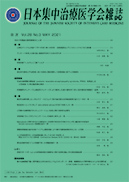Volume 28, Issue 3
Displaying 1-21 of 21 articles from this issue
- |<
- <
- 1
- >
- >|
-
2021Volume 28Issue 3 Pages 167
Published: May 01, 2021
Released on J-STAGE: May 01, 2021
Download PDF (161K)
-
2021Volume 28Issue 3 Pages 169
Published: May 01, 2021
Released on J-STAGE: May 01, 2021
Download PDF (299K) -
Neurally adjusted ventilatory assist (NAVA) mitigates ventilator-induced diaphragm injury in rabbits2021Volume 28Issue 3 Pages 170
Published: May 01, 2021
Released on J-STAGE: May 01, 2021
Download PDF (307K) -
2021Volume 28Issue 3 Pages 171
Published: May 01, 2021
Released on J-STAGE: May 01, 2021
Download PDF (327K) -
2021Volume 28Issue 3 Pages 172
Published: May 01, 2021
Released on J-STAGE: May 01, 2021
Download PDF (262K)
REVIEW ARTICLES
-
2021Volume 28Issue 3 Pages 173-179
Published: May 01, 2021
Released on J-STAGE: May 01, 2021
Download PDF (353K) -
2021Volume 28Issue 3 Pages 180-188
Published: May 01, 2021
Released on J-STAGE: May 01, 2021
Download PDF (628K)
COMMENTARY ARTICLE
-
2021Volume 28Issue 3 Pages 189-195
Published: May 01, 2021
Released on J-STAGE: May 01, 2021
Download PDF (1690K)
ORIGINAL ARTICLE
-
2021Volume 28Issue 3 Pages 197-204
Published: May 01, 2021
Released on J-STAGE: May 01, 2021
Download PDF (366K)
CASE REPORTS
-
2021Volume 28Issue 3 Pages 205-209
Published: May 01, 2021
Released on J-STAGE: May 01, 2021
Download PDF (265K) -
2021Volume 28Issue 3 Pages 210-213
Published: May 01, 2021
Released on J-STAGE: May 01, 2021
Download PDF (523K)
BRIEF REPORTS
-
2021Volume 28Issue 3 Pages 215-216
Published: May 01, 2021
Released on J-STAGE: May 01, 2021
Download PDF (251K) -
2021Volume 28Issue 3 Pages 217-218
Published: May 01, 2021
Released on J-STAGE: May 01, 2021
Download PDF (243K) -
2021Volume 28Issue 3 Pages 219-221
Published: May 01, 2021
Released on J-STAGE: May 01, 2021
Download PDF (219K) -
2021Volume 28Issue 3 Pages 222-223
Published: May 01, 2021
Released on J-STAGE: May 01, 2021
Download PDF (359K) -
2021Volume 28Issue 3 Pages 224-226
Published: May 01, 2021
Released on J-STAGE: May 01, 2021
Download PDF (252K) -
2021Volume 28Issue 3 Pages 227-229
Published: May 01, 2021
Released on J-STAGE: May 01, 2021
Download PDF (595K) -
2021Volume 28Issue 3 Pages 230-231
Published: May 01, 2021
Released on J-STAGE: May 01, 2021
Download PDF (310K) -
2021Volume 28Issue 3 Pages 232-233
Published: May 01, 2021
Released on J-STAGE: May 01, 2021
Download PDF (305K)
LETTER
-
2021Volume 28Issue 3 Pages 235
Published: May 01, 2021
Released on J-STAGE: May 01, 2021
Download PDF (142K)
COMMITTEE REPORT
-
2021Volume 28Issue 3 Pages 237-254
Published: May 01, 2021
Released on J-STAGE: May 01, 2021
Download PDF (701K)
- |<
- <
- 1
- >
- >|
